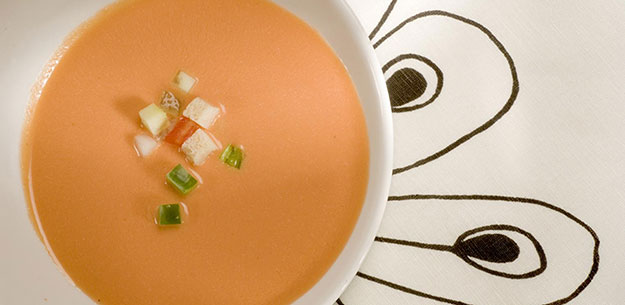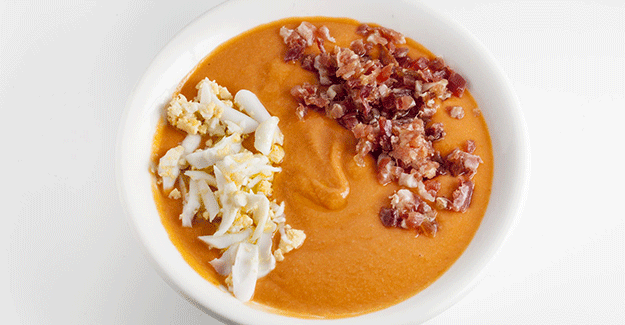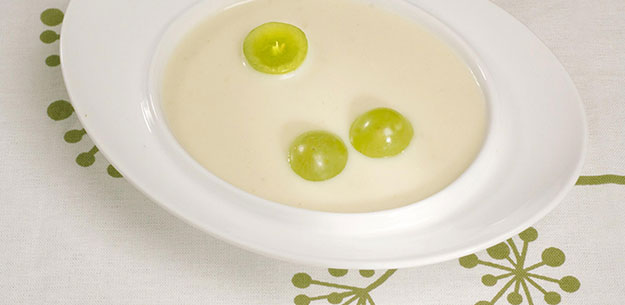.png.transform/rendition-xs/image_image%20(1).png)
Spanish Cold Soups For When It's Too Hot
What is the king of summer recipes? Without a doubt, it’s gazpacho. Fortunately, it belongs to a family of wonderful royal relatives. Let’s take a look at our cookbook, in search of refreshment, nutrition and enticing flavors.
Ripe tomatoes, cucumber, pepper, white bread, extra virgin olive oil, vinegar, water, salt and a touch of garlic; put them together in a bowl and all they need is a blender to turn them into a cold soup. These ingredients, and nothing more, are what go into traditional Andalusian gazpacho, a dish that, contrary to what it might seem, was popular only in the south of Spain until a few decades ago.
According to food writer and critic Cristino Álvarez, who specialized in Spanish cuisine: “In the 1960’s it wasn’t common to bring together the concepts of soup and cold in one plate, in fact they seemed almost mutually exclusive.” The origins of gazpacho are found, “in the eating habits of Andalusian farmers, who had to endure hard days of working in the fields and extremely high temperatures”. From here, popular imagination “created a refreshing recipe using easy-to-come-by vegetables that, above all, were very nutritious”.
In general, when we talk about gazpacho, we are usually referring to the red gazpacho from Seville, which uses tomatoes as the main ingredient. We can therefore trace this dish’s origins to the 17th century when the earliest references were made to the culinary adaptation of this vegetable, which made its way to Europe thanks to the Spanish conquest of American territories.
One of these testimonies was offered by Francisco Hernández in his tome, Rerum Medicarum Novae Hispaniae Thesaurus, published around 1630. There he alludes to the recipe for the gazpacho of the future in his description of how they (tomatoes), when dressed with olive oil and vinegar and “ground up and mixed with chili, make a very nice sauce which improves the taste of nearly all foodstuffs and stimulates the appetite”
The freshness of gazpacho

Given the correct proportion of ingredients, gazpacho is a simple and quick recipe that need only chill for a few hours in the refrigerator to reach the desired temperature. It can be served as a first course, as an appetizer in a small glass, or as a refreshing mid-morning or mid-afternoon snack. It captures the essence of culinary simplicity in the name of good health, thanks to its high levels of vitamins, antioxidants and minerals. The only fat found in this cold soup comes from its extra virgin olive oil. This healthy, monounsaturated fat containing oleic acid is beneficial for the prevention of cardiovascular diseases.
There are many restaurants, particularly in Andalusia, where good gazpacho is considered a gastronomic jewel. One of these is El Churrasco, in the center of the historic city of Córdoba, whose recipe reflects a maximum respect for popular Andalusian tradition. Another well-known example is the gazpacho made at Juanito, a family-owned restaurant in Úbeda (Jaén) that is renowned for its home cooking.
As has become the norm in recent years, tradition has served as inspiration for the great chefs of Spanish avant-garde cuisine, and gazpacho has been no exception. Creative minds like that of Andalusian chef José Carlos García (of the restaurant by the same name in Malaga) have been creating appetizing versions of this dish like his Strawberry gazpacho with Ibérico ham dust and oyster snow.
Outside of Spain, gazpacho is included on the menus of many prestigious restaurants. An example of this is the version prepared by Chef Nacho Manzano at his Ibérica restaurants in the UK, where the menu features a Gazpacho of red berries, beetroot & anchovy.
The simplicity of 'salmorejo'

Although gazpacho is currently one of the most recognizable Spanish dishes in the world, it’s only fair to note that Spanish cuisine includes a range of other equally appetizing and healthy cold soups. It’s also important to remember that the majority of cold Spanish soups are from the same region, Andalusia, due to its hot climate.
One of these is salmorejo, a cold soup that shares some of the same ingredients as gazpacho, but that also asserts its own identity. The growing international popularity of this soup is demonstrated by its increasingly frequent appearances on the menus of Spanish restaurants abroad (José Andrés offers it in Jaleo), or as the subject of articles in international publications, such as one published in The Wall Street Journal .It can be said that salmorejo and gazpacho are cousins. Both recipes include tomatoes, bread, extra virgin olive oil, vinegar (best if it’s Sherry vinegar) and a clove of garlic. In the case of salmorejo, however, the final result is creamier and less acidic than gazpacho, and is served with small pieces of Ibérico or Serrano ham and hard-boiled egg.
For most people, Córdoba is the cradle of salmorejo, a city where it is served both as a main course and as part of a rich pairing with breaded eggplant and Spanish tortilla (potato omelet), among other tapas. Andalusian restaurant Sanlúcar, located in the center of Madrid, pays worthy homage to this traditional recipe. Hot summer Sundays in the Spanish capital are infinitely easier to bear while enjoying salmorejo and a glass of chilled manzanilla in this tavern hidden in the popular neighborhood of La Latina.
The delicacy of 'ajoblanco'

The third typically Andalusian cold soup is ajoblanco. If gazpacho is sentimentally connected to Seville and salmorejo to Córdoba, then ajoblanco is linked in its heart and soul to Málaga. With this soup we leave the red and orange colors behind, and move on to ivory, almost white tones. Ajoblanco is a cold soup made with raw almonds, extra virgin olive oil, vinegar, a little bit of garlic, water and salt. It is traditionally accompanied by grapes or even small pieces of melon.
Avant-garde chefs have also been seduced by this evocative cold soup. Dani García, of Calima restaurant in Marbella, created the surprising recipes for Cherimoya ajoblanco, Lustau East India Solera and essence of orange and lemon.
But if what we are looking for is a typical ajoblanco, with the flavors and textures dictated by the traditional recipe, a good option is to go up to the overlook of the Parador of Málaga Gibralfaro, and take in panoramic views of the city while enjoying the delicate quality of this summer soup.
Available in gourmet stores
Despite the fact that gazpacho, salmorejo and ajoblanco are not complicated to make at home, provided that top quality Spanish ingredients are used, it is not unusual for consumers to purchase these cold soups in pre-prepared, ready-to-eat form. For years it was unthinkable, but now there are several Spanish food companies that sell these cold soups, which are made using a careful selection of raw materials without loosing sight of the original recipes. The ability to keep the soups refrigerated throughout the production process makes it possible to keep them in optimum conditions.
One of the leading companies in the export of pre-prepared cold soups is Alvalle, which belongs to Tropicana and has its headquarters in the Region of Murcia. Sources from the company affirm that 40% of the gazpacho made in the Murcia factory is exported to countries like France, Belgium, Germany, Switzerland and the United Kingdom. Companies that produce in smaller volume, like Bajamar-Mamía from Navarra or Ferrer from Catalonia, have also managed to successfully place their gazpachos on the shelves of gourmet stores in Europe and the United States.

